Showing posts with label Meditation. Show all posts
Showing posts with label Meditation. Show all posts
Thursday, January 22, 2015
Wednesday, June 18, 2014
How To Make Your Own Incense
by Rosalee de la Forêt
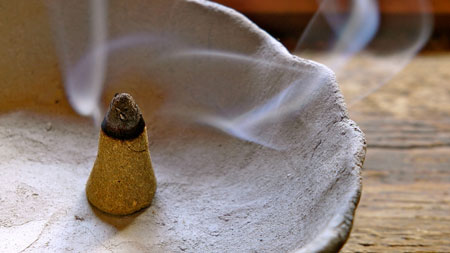
This next holiday HerbMentor newsletter is another herbal craft idea that comes from thousands of years of tradition.
The word incense literally means ‘to burn’. For thousands of years people have burned plants and resins as religious rites, as a purification process, for protection, to cleanse the air, to repel pests or simply to enjoy a pleasant scent perhaps masking bad odors.
Incense has a long tradition of use in the far east; some even say that the making and burning of incense blends is more of an art form than a utilitarian purpose.
Today we are going to learn to make cone incense. Cone incense was invented in Japan in the 1800’s. It is easy to make and burns relatively fast.
By making our own incense we know exactly what plants and resins are being used and we don’t have to worry about potentially toxic fillers in our incense. Even though we are using pure products, it is always best to burn incense in a well-ventilated area.
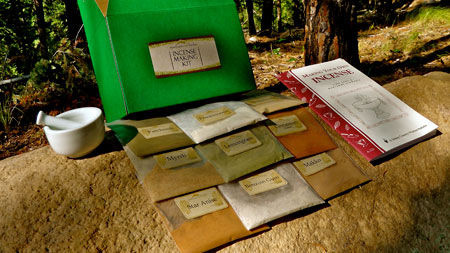
To make this incense I used a kit from Mountain Rose Herbs. The kit includes everything you need to make your own incense, including...
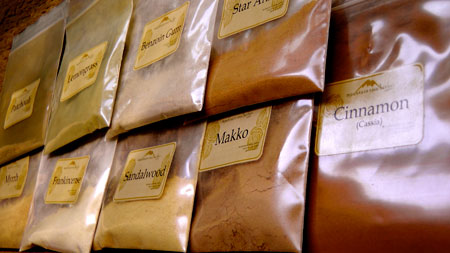
a variety of different powdered herbs...
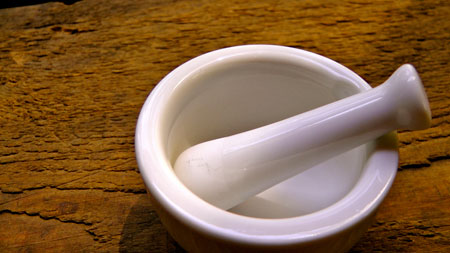
a small mortar and pestle...
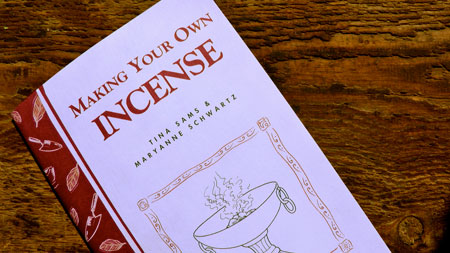
and a book on how to make your own incense, such as this one by our friend Tina Sams. This book contains a lot of different recipes for making your own incense. It also describes how to make powdered incense, cone incense and stick incense.
It isn’t necessary to buy the kit in order to make incense, however. You can also buy these powdered herbs at your local herb store or Mountain Rose Herbs.
There are many different incense recipes. I chose the following one as an example.
To make our incense we are going to combine the following...
- 3/4 teaspoon makko
- 1 teaspoon lemongrass
- 1/2 teaspoon frankincense
- 1/2 teaspoon sandalwood
- 1/4 teaspoon benzoin gum
- Click here to go directly to the Incense Kit and the above book
- Click here for Mountain Rose Herbs Main Product Index in case you already have some of the ingredients.
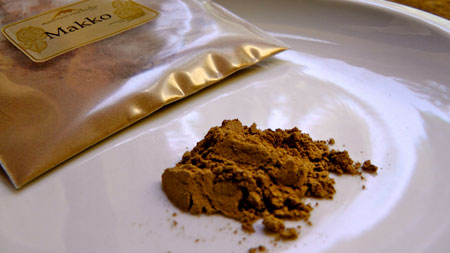
Makko is a prominent base ingredient for making incense.
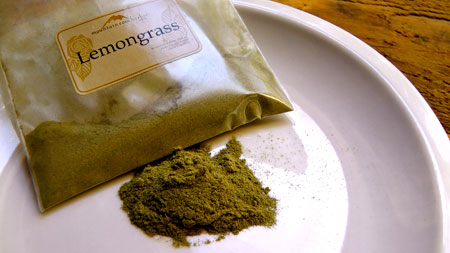
Lemongrass is one of my favorite tea herbs, it has a lovely pleasant scent when burned. It is also used to keep away bugs.

Frankincense is a famous incense that comes from the resin of a boswellia tree.
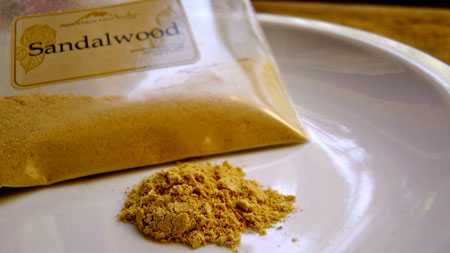
Sandalwood is a heavenly scent. Be sure to source this from an ecologically sound source.
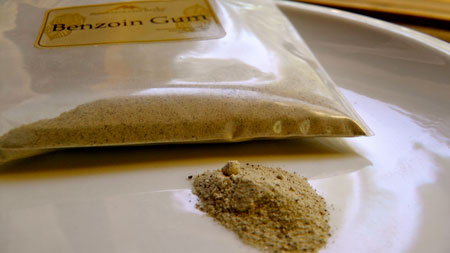
Benzoin gum is frequently used as a preservative in cosmetics and soaps. It has a mild, vanilla-like scent.

All of these powders can be combined in a small mixing bowl.
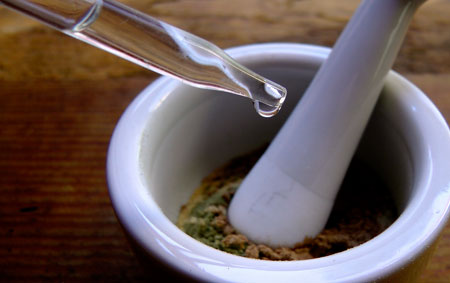
Next we’ll add small amounts of water to the mix until the powders can be formed into a malleable paste. I do this using a pipette dropper so that I can add water very slowly to avoid adding too much.
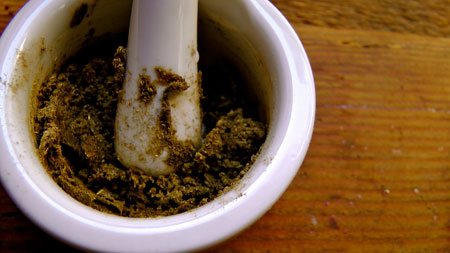
Add a little bit of water, stir, then add a little bit more until the mixture forms the consistency of play dough.
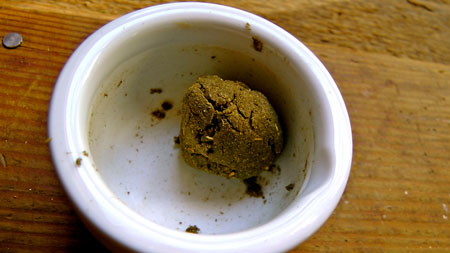
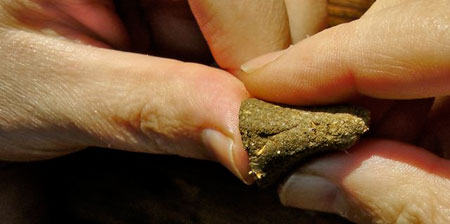
Once it is a paste, we can shape it into cones. To do this use your thumb as a base while you use your other hand to form the cone. Don’t make these too big or you’ll have difficulties getting them lit.
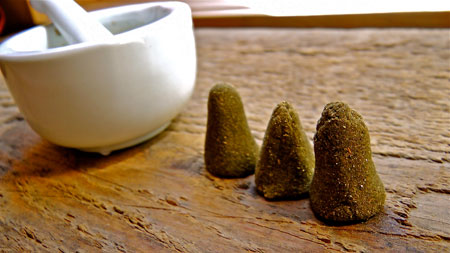
Place each of these cones on a piece of wax paper or other hard surface and let them dry for 24 hours.
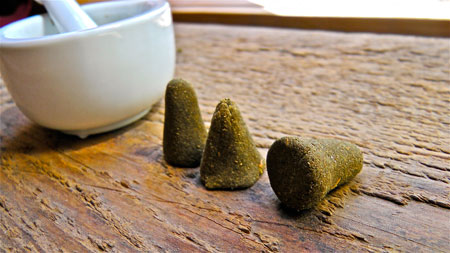
After 24 hours, lay these cones on their side to allow air circulation to the bottom of the cone.
Depending on your climate these may take 25 - 36 hours to completely dry.
Once they are completely dried they can be stored in an air-tight container until ready to use.
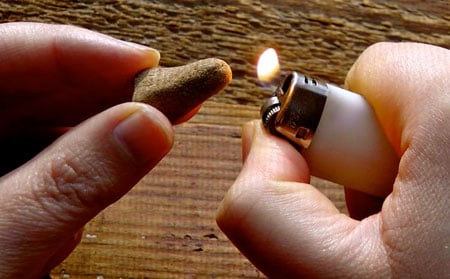
To use these incense take one cone and place it on a fire-safe surface. Using a match or lighter, light the very tip of the cone, let it burn for a moment, and then blow it out.
The cone will continue to smolder, giving off a pleasant scent, until all the incense is burned. Remember to burn these in a well-ventilated area.
Incense is a great way to bring a variety of pleasant scents to your home.
These also make great gifts.
Again, you can get all you need right here to get started.
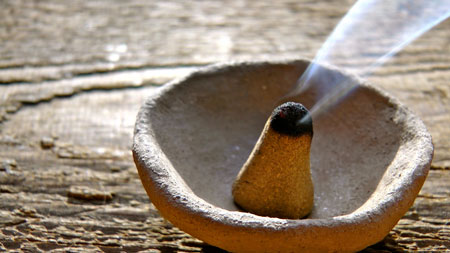
Have fun!
~Rosalee
Labels:
Benzoin,
Frankincense,
incense,
Lemongrass,
Makko,
Meditation,
Sandalwood,
Video
Tuesday, June 17, 2014
FRANKINCENSE & MYRRH FOR WONDERFUL MEDITATION

FRANKINCENSE :
What are the Documented Uses and Benefits of Frankincense? Asthma, cancer, depression, infection (colds, coughs, pneumonia, respiratory, staph, strep), immune stimulant, inflammation, meditation, muscles, nervous conditions, spiritual connection, supports the nervous system, stress, ulcers and vertigo.
What are the Documented Uses and Benefits of Frankincense? Asthma, cancer, depression, infection (colds, coughs, pneumonia, respiratory, staph, strep), immune stimulant, inflammation, meditation, muscles, nervous conditions, spiritual connection, supports the nervous system, stress, ulcers and vertigo.
What is the Aromatic Affect on the Mind? It is uplifting and centering. Has a sweet, balsamic and warm aroma with incense-like overtones.
What is the Spiritual Influence? Sacred Frankincense Essential Oil has been used to awaken our spiritual awareness and connect with spirit for 5000 years or more. It will help us release parts of our ego which hold us back from connecting with our soul, as well as feelings of unworthiness and insecurity.
Once we are able to connect with our spiritual side, we can embrace our true purpose in the world and become more spiritually driven rather than ego driven.
Use Sacred Frankincense Essential Oil during meditation to connect with spirit and stay centered in yoga or meditation sessions.
What Chakra is Affected? Opens the heart, throat, third eye and crown chakras.
Most Interesting Historical Reference?
Did you know that Frankincense was traded over 5000 years ago in North Africa and on the Arabian Peninsula?
Did you know that Frankincense Oil was found in King Tutankhamen’s tomb in Ancient Egypt? King Tut died in 1323 BC!
Frankincense is a wonderful meditation tool that can help if you are having difficulty keeping the rampant mind at bay. Using Frankincense deepens your meditative practice and helps you to keep focused.
Frankincense is an ancient tree resin that has been used for centuries in sacred ceremonies, religious rituals, spiritual meditation and holistic medicine. It was in widespread use by the Egyptians, Assyrians, Babylonians, Greeks and Romans.
Frankincense resin comes from the Boswellia tree which grows in mainly Africa. To collect the sap, the tree bark is cut and the sap is allowed to ooze out of the bark. The sap dries on the tree and is then collected.
As incense, the raw chunks of resin are directly set on a heat source, such as hot coals. Burning Frankincense is believed to affect the crown charka. It helps with meditation by deepening the breath and brining the body and mind into a harmonious state. There is a quality to the scent of burning Frankincense that seems to reach a forgotten corner of the mind. It is an exotic, yet familiar smell that can assist in promoting spiritual focus and creativity.
As a medicinal substance Frankincense was thought to cure vomiting, diarrhea, fever, and tumors. It is also used to treat skin inflammation, headaches and allergies. In China it is used to treat leprosy and gonorrhea. Frankincense is edible and can also help with digestion. Ayurvedic medicine uses Frankincense for treating arthritis.
Edible Frankincense must be pure for internal consumption. It should be translucent without any impurities. It is often chewed like gum, but it is stickier because it is a resin.
Frankincense has also been used in Aromatherapy to relieve anxiety and promote a sense of well-being. It is used to alleviate depression.
Personally, it feels as if burning Frankincense during your day helps to encourage sacredness in your life. Give it a try
 MYRRH :
MYRRH :
Most Interesting Historical Reference?
Did you know that Myrrh is recorded in Ebers Papyrus, one of the oldest Egyptian medical texts on record? Ebers Papyrus dates to about 1550 BC and contains over 700 remedies for almost everything including cancer, asthma and of course, embalming.
Where is the name derived from? Myrrh comes from an Arabic word "murr" meaning "bitter".
Why is this information so important? Its not, it’s just a fun fact!
What are the Plant Properties? Antioxidant, anti-inflammatory, antitumoral, analgesic, anti-infectious, antiviral, anti-parasitic, antiseptic, astringent and tonic.
What are the Documented Uses and Benefits of Myrrh?Bronchitis, diabetes, cancer, viral hepatitis, fungal infections (Candida, eczema, ringworm, athletes foot, vaginal thrush), tooth and gum conditions, skin conditions (wrinkles, stretch marks, chapped, cracked), diarrhea, dysentery, hyperthyroidism, and ulcers.
What is the Aromatic Affect on the Mind? Its warm and woody aroma is uplifting.
What is the Spiritual Influence? The benefits of Myrrh include the spiritual and emotional as well. Myrrh is very spiritual oil and has been used in religious ceremonies and rituals for over 5000 years!
Myrrh releases fears, difficult or painful experiences as it relates to us or the world. It asks us to be more accepting, trusting and non-judgmental of ourselves.
When we can love and trust ourselves more, than we don’t attract situations that are as painful and we learn to integrate our physical with our spiritual being.
Because this oil opens the heart chakra and is uplifting to the mind, it can relieve anxiety, stress and depression. Place on the heart to release this patterning and embrace relationships (self and others).
What Chakra is Affected? Promotes opening of the solar plexus and heart chakras.
What is the corresponding Chakra Color? Red and pink.
How do I use it?
Use NEAT (undiluted). Then,
- Apply several drops (2-4) on location
- Apply to chakras/vitaflex points
- Directly inhale
- Diffuse, or
- Dietary Supplement.
Thursday, May 29, 2014
Friday, January 10, 2014
Vibrational Frequency and the Subtle Energy Nature of Essential Oils
There is a subtle bio-energy that flows through all organic life. It goes by many names and is sometimes referred to as Chi or life force. This energy is expressed as an electromagnetic vibrational frequency – and pure essential oils have the highest frequencies of any measured natural substance.
What is vibrational frequency? And why do we care about it?
A review of our grade school science lessons reminds us that everything vibrates. Every atom in the universe has a specific vibratory or periodic motion. Each periodic motion has a frequency (the number of oscillations per second) that can be measured in Hertz. Every element in the Periodic Table has a specific vibratory frequency.
Most plants (and animals) use enzymes to break down molecular components during their life processes. And each of these enzymes has a unique crystalline form with a specific vibratory frequency.
The vibrational frequency of an oil reflects the integrity of these elements and enzymes embodied within its substance –its bio-energy or life force and its original intent. This factors into an oil’s potential therapeutic value.
Measuring Vibrational Frequencies
During his work with plants, soil, and water in his agricultural projects, Bruce Tainio of Tainio Technology invented and built a machine called a BT3 Frequency Monitoring System. This device – modified and perfected over the years - used a highly sensitive sensor to measure bio-electrical frequencies of plant nutrients and essential oils.
To summarize how it worked - As a Hertzian wave is generated and travels out from its source, it transfers energy to the objects it passes through. The frequency monitor’s sensor measures the nano voltage of that wave, using the predominant frequency in the megahertz range, filtering out the lower and higher ranges. The BT3 measures the composite frequency of the vibratory emissions in electrical voltage – MHz - of the elements and enzymes remaining in the oils.
See - www.coherentresources.com/bt3_monitor.php Although Tainio no longer produces the BT3 Monitor for reasons noted on the website, the findings gleaned from his research conducted over the years with this device are remarkable.
For example, here are the average frequencies of some of the therapeutic grade essential oils that have been measured:
- Rose (Rosa damascene).....................320 MHz
- Lavender (Lavendula angustifolia)........118 MHz
- Myrrh (Commiphora myrrha)................105 MHz
- Blue Chamomile (Matricaria recutita).....105 MHz
- Juniper (Juniperus osteosperma)............98 MHz
- Aloes/Sandalwood (Santalum album)......96 MHz
- Angelica (Angelica archangelica)...........85 MHz
- Peppermint (Mentha peperita)..............78 MHz
- Galbanum (Ferula gummosa).................56 MHz
- Basil (Ocimum basilicum)......................52 MHz
The measured frequencies of essential oils begin at 52 MHz, the frequency of basil oil, and go as high as 320 MHz — the frequency of rose oil. For comparison, fresh produce has a frequency up to 15 MHz, dry herbs from 12 to 22 MHz, and fresh herbs from 20 to 27 MHz. Processed and canned foods have no measurable frequency whatsoever.
Human Electrical Frequencies and Fields
Dr. Robert O. Becker, in his book The Body Electric, tells us that the human body has an electrical frequency, and also that much about a person's health can be determined by its frequency levels.
In addition to his plant studies, Tainio developed a way to use his machine to measure human electrical vibrational frequency by taking readings on various points of the body and averaging those numbers together. His measurements indicate that the daytime frequency of a healthy human body vibrates in the range of 62 to 68 MHz.
Intriguing as Tainio’s research is, its foundation may have been laid in the early years of the 20th century by Dr. Royal R. Rife, M.D. (1888-1971). Dr. Rife conducted research with a machine he developed called a “frequency generator” that applies currents of specific frequencies to the body. He concluded that every disease has a specific frequency.
According to Dr. Rife every cell, tissue and organ has its own vibratory resonance. Working with his frequency generator, he found that specific frequencies would destroy a cancer cell or a virus. His research demonstrated that certain frequencies could prevent the development of disease, and that others would neutralize disease.
Bjorn Nordenstrom, a radiologist from Stockholm, Sweden, discovered in the early 1980s that, by putting an electrode inside a tumor and running a milliamp of DC current through the electrode, he could dissolve a cancer tumor and stop its growth. He also found that the human body had electropositive and electronegative energy fields.
Studies conducted in 1992 by Tainio Technology, as an independent division of Eastern State University in Cheny, Washington, reinforce the findings of these earlier researchers. Tainio and colleagues determined that when a person's frequency drops below the optimum healthy range, the immune system is compromised. Findings supported by this research indicate that:
- Human cells can start to change (mutate) when their frequency drops below 62MHz.
- 58 MHz is the frequency of your body when you have a cold or the flu.
- When candida is present within your body, you vibrate at a frequency of 55MHz.
- 52 MHz is the frequency of a body with Epstein-Barr virus present.
- 42 MHz is the frequency of a body wherein cancer can appear.
- When the death process begins - the frequency has been measured at 20 MHz.
Effects of Outside Influences on Body Frequency
The study of frequencies raises an important question – how do the frequencies of substances found in our environment affect our personal frequency? Based on his studies, researcher Nikola Tesla said that, if we could eliminate certain outside frequencies that interfered in our bodies, we would have greater resistance toward disease.
Pathogens have a low frequency. Pollutants - both particulate and radiation (EMF) - lower a healthy frequency. Processed and canned food having a frequency of zero can greatly diminish a person's own frequency.
Even thoughts and feelings have a vibratory quality that forms a measurable frequency. A negative mental state can lower a person's frequency by 10-12 MHz.
Likewise, a substance or influencing factor - such as thoughts, emotions, and frequency devices - in our internal and external environments can also serve toraise our frequencies. For example, a positive mental attitude, prayer or meditation can raise it by 10-15 MHz.
A substance with a higher frequency can raise a lower frequency due to the principle of entrainment - the tendency for two oscillating bodies to lock into phase so that they vibrate in harmony. This principle is key to understanding the effect essential oils can have on our personal electromagnetic frequency.
However, different types of frequencies can have a chaotic or a harmonizing effect on our own systems. When something vibrates at many dissonant frequencies, it produces “chaotic or incoherent frequencies.” (David Stewart,The Chemistry of Essential Oils Made Simple).
For example, all of the electrical devices in your home – lamps, television, radio, phone, microwave – emit electromagnetic vibrational frequencies that are incoherent and chaotic. Their effect is to fracture the human electrical field.
By contrast, Dr. Rife’s frequency generator and most naturally occurring substances –including essential oils – have coherent frequencies that resonate harmoniously with the electrical field of the human body.
The Healing Process and the Subtle Energy Nature of Essential Oils
The human body vibrating within its normal vibratory range between 62 and 68 MHz is considered in a state of health. But energy disturbances in the subtle bodies will actually precede the appearance of disease and illness in the physical body.
The normally harmonious coherent frequencies of the body easily go out of “tune” when a person experiences physical or emotional stress. A blockage of the flow of life energy – characterized by inflammation, irritation and illness – can result. When the human frequency range drops below the norm of 62 megahertz, this is when abnormal processes can begin to develop.
When disease and illness are present, they may manifest as chemical imbalances. But underlying this is an electromagnetic imbalance that has altered the specific vibrational frequencies of molecules, cells, tissues and organs within the body.
Properly “retuning” the body to its original frequency brings it into balance and restores its natural harmonic resonance – illness either doesn’t manifest or is resolved.
Dr. Richard Gerber MD, author of Vibrational Medicine, tells us that one of the best ways we can change dysfunctional patterns in our energy bodies is to administer therapeutic doses of “frequency-specific subtle energy in the form of vibrational medicines.”
And researcher Jim Oschman, PhD, who wrote Energy Medicine, refers to natural substances from the plant kingdom he calls “energetic pharmacology” (as distinguished from chemical pharmacology). Therapeutic grade essential oils produce coherent frequencies that are naturally tuned to the health of our bodies. Pharmaceuticals and synthetic oils do not.
The intention of this healing process is to provide the correct frequency that will bring the body back to a state of coherence, to a state of equilibrium. Terry Friedman, in his book, Freedom Through Health tells us that raising our vibrational frequency aids in “restoring health to the body, clarity to the mind and attunement to the spirit.”
By applying an essential oil with a particular frequency to the human body – through the principle of entrainment - the oil’s higher frequency will raise the vibratory quality of that individual. When several oils are blended together, each having a different MHz frequency, a frequency will emerge that may be higher or lower than the various components. The therapeutic properties create special vibrational remedies capable of healing or rebalancing the body/mind/soul/spirit.
And because each oil has a specific frequency, and our organs and body systems and the nutrients needed to maintain optimum health each have their specific frequencies, the oil's electrical affinity to these components of our bodies will enhance and support these organs and body systems, and will aid in the assimilation of nutrients.
Essential oils in the higher frequency ranges tend to influence the emotions. EOs in the lower frequencies have more effect on structural and physical changes, including cells, hormones, and bones, as well as viruses, bacteria, and fungi.
Essential oils don’t resonate with the toxins in our bodies. This incompatibility is what helps eliminate the toxins from our systems. Neither do they resonate with negative emotions. So they can help dislodge forgotten traumas by surfacing them in our consciousness where we can deal with them and let them go.
Clinical research shows that essential oils have the highest frequency of any natural substance known to man, creating an environment in which disease, bacteria, virus, fungus, etc., cannot live. I believe that the chemistry and frequencies of essential oils have the ability to help man maintain the optimal frequency to the extent that disease cannot exist.
Gary Young of Young Living Essential Oils
The beauty of using therapeutic grade essential oils to restore coherent healthy vibrational frequencies to the body is that they are:
- Affordable
- Accessible
- Effective
- Versatile
Essential oils offer us a natural way to restore our body's healthy electromagnetic vibrational frequency. The elegance of their holism allows for easy functionality in our daily lives. Their constant subtle presence gently resonates with our body’s electrical fields aiding and restoring harmonic health and well-being on all levels.
Ancient Perfume Recipes - Smell like an Egyptian
Smell like an Egyptian
AN ANCIENT EGYPTIAN RECIPE
Grind up 270g of reed roots, Acorus Calamus, Lemongrass, Pistachio Nuts, Cinnamon, Mint and wood of the Myrtle Tree. Separately grind up 270g of Juniper Berries, Chaerphyllum (a green leafy herb) and Cyperus Longus roots, equivalent to Spanish "horchata". Mix the two powders together and combine with Grape Wine. Leave to sit for one day. Bring 1.2kg of incense and 3kg of honey to boil and reduce to 3.36kg. Add 1kg of ground myrrh. Mould into round balls about one centimeter in diameter. Put the perfume in a long pipe and burn.
Egyptian Perfume : Make your own
Are you dying to capture the ancient essence of regal Egyptian Pharaohs? Thanks to an archeological find and some hieroglyphic deciphering, the solid perfume ball Kyphi, is no longer just for mummies, this ancient scent was used by ancient rulers such as Nefertiti and Tutankhamun.
After six years of research the cosmetic manufacturer L'Oreal released the ancient recipe based on knowledge of oils found in toiletry vessels looted by Napoleon's forces, together with inscriptions of recipes found on ancient Egyptian temple walls. The product would have been burnt over charcoal 4000 years ago, and not applied to the skin, the ancient method creates a primary aroma of lemongrass followed by the scent of peppermint then juniper berries and cinnamon. It would slowly soak into your skin as you burn the scent.
Ancient Egyptians used three methods of releasing fragrance. Perhaps the oldest method was via burning. This technique is evoked and recalled in the modern word perfume, literally "through smoke". Fragrant materials could also be added to oils or to animal fats (goose, pork or ox), or fruit pastes, like the legendary kyphi, a temple fragrance, which was based on raisins. These fragrances would look and feel different from what we call perfume today.
Perfume Oils sold in my eBay store are PURE ESSENTIAL OILS and contains NO ALCOHOL and safe to send via Australia Post or International Post. This type of oil is used as a base in commercial perfumes and other products, with most of these scents having remedial/therapeutic properties, such as :-
CAMPHOR = anti-inflammatory, antiseptic, cardiac, diuretic, insecticide, laxative, stimulant.
SANDALWOOD = aids meditation, builds confidence.
MORE details coming soon in other Guides.
Tutankhamun's Perfume
One quarter cup of Coconut Oil
6 drops of essential oil of Spikenard
6 drops of essential oil of Frankincense
Blend liquid oil with essential oils, place in a container and leave to stand at room temperature until it hardens. This recipe is ideal for mature skin, minimizing wrinkles and delaying signs of aging.
A variation is to substitute with a thinner vegetable oil, less inclined to clog pores than coconut, eg, grapeseed or jojoba. This combination of oils will remain liquid. Before you go to bed massage a small amount into your face. Both oils have a reputation of being an aphrodisiac, so please be careful....lol
ESSENTIAL OILS WITH APHRODISIAC PROPERTIES
Lavender, Gardenia, Jasmine, Rose & Vanilla
CLEOPATRA'S PERFUME RECIPE
Mix Sandalwood, Rose, Lavender, Franincense and Basil. Mix of few drops of each oil to a carrier/base oil and use as a massage balm. This combination of oils possesses meditative properties and arouses the senses, creating harmony to stimulate the body mind and spirit and encourages sexual desire and performance.
Legend - Cleopatra conquered the Romans with her aromatic perfumes and Bathsheba seduced King David with her perfumed baths.
Labels:
Bible Perfume,
Coconut Oil,
Cyperus,
Fragrance of Ancient Scripture,
Frankincense,
Gardenia,
Grapeseed Oil,
jasmine,
Juniper Berries,
Meditation,
Perfume,
Recipe,
Rose,
Spikenard,
Vanilla,
Vegetable Oil
Twelve Oils Of Ancient Scripture

An Historical Perspective
The oils and aromatics mentioned in the Bible were more valuable than gold and silver. Israel’s King Hezekaih kept “the spices, and the precious ointment” (2 Kings 20:13) together with silver and gold in the royal treasure chamber.
Merriam-Webster’s Collegiate Dictionary defines anoint as “to apply oil to as a sacred rite, especially for consecration.” It has been suggested that the holy anointing oil described in Exodus 30:23-25 is a symbol of being set apart for special purposes in God’s kingdom. People and objects were anointed throughout the Bible: Aaron and his sons were anointed priests, the Tabernacle and all of its vessels were anointed before being put into service, and Saul and David were anointed to be kings. The Hebrew word for Messiah, Moschiach, means “Anointed One.” Jesus Christ was twice anointed with the oil of spikenard, which was so expensive that Judas was indignant that it wasn’t sold to raise money for the poor.
God mandated that the anointing oil be fragrant when He instructed Moses to add spices and fragrant oils to the base of pure olive oil. Psalm 45 informs us that the garments of the Messiah are fragrant with myrrh, aloes, and cassia. In one Bible translation of Philippians 4:18, Paul described gifts given as “a fragrant aroma, an acceptable sacrifice, well-pleasing to God.”
Incense was offered twice daily in the Tabernacle and later in the temple in Jerusalem. In Proverbs 27:9 we are told “ointment and perfume rejoice in the heart.” The New Testament suggests that incense offering represents the prayers of saints. In Revelation 5:8, “four beasts and four and twenty elders fell down before the Lamb, having every one of them harps, and golden vials full of odours, which are the prayers of saints,” the King James translators chose to translate the Greek word “thumiama” as “odours” rather than “incense”. According to Strong"s Exhaustive Concordance of the Bible, “thumiama” ritual use of incense represented God’s power over life and death in Numbers 16:46-48 wherein the High Priest Aaron walked through the congregation with it, stopping a deadly plague.
Therapeutic Effects of the
Twelve Oils of Ancient Scripture
Twelve Oils of Ancient Scripture
Considering there are 12 oils mentioned numerous times throughout the Holy Scriptures it is no coincidence that God has given these oil to mankind to sustain a healthy body. These oils alone address all the body systems and appear to be prophetic when considering the volatile times fast approaching God’s people. A brief synopsis of the oils will be presented to further educate those interested in taking responsibility for their own health.
Aloes/Sandalwood – (Santalum album)
“And there came also Nicodemus, which at the first came to Jesus by night, and brought a mixture of myrrh and aloes, about a hundred pound weight” (John 19:39). Many botanists believe that aloes was derived from sandalwood, one of the oldest incenses known to man. Its 4,000-year history includes use as a carved wood as well as distillation for its sweet-, woody-, and fruity-scented oil. The great quantity of myrrh and aloes used in preparing Christ’s body for burial was indicative of respect.
Action: Sandalwood is high in sesquiterpenes that have been researched in Europe for their ability to stimulate the pineal gland and the limbic region of the brain. The pineal gland is responsible for releasing melatonin, a powerful antioxidant that enhances deep sleep. Sandalwood is similar to Frankincense oil in its support of nerves and circulation.
Indications: Bronchitis (chronic), herpes, cystitis, and skin tumors.
Uses: May help with cystitis and urinary tract infections. It may also be beneficial for acne, depression, pulmonary infections, menstrual problems, nervous tension, and skin infection. It may help dry or dehydrated skin.
Emotional Uses: May unlock emotional trauma fro DNA of cells, oxygenate the pineal and pituitary glands, thus improving attitude.
Cassia – (Cinnamomum cassia)
Cassia – (Cinnamomum cassia)
“All thy garments smell of myrrh, and aloes, and cassia, out of the ivory palaces, whereby they have made thee glad” (Psalm 45:8). Two of the oldest known spices in the world are cinnamon and cassia. It was an ingredient in the holy anointing oil and the incense that was burned daily in the temple. While its aroma is similar to cinnamon, cassia is chemically and physically quite different.
Action: Antibacterial, antiviral, and anti-fungal.
Traditional Uses: The British have used this oil specifically for flatulent dyspepsia or colic with nausea. In Chinese medicine it is used particularly for vascular disorders. Cassia oil is among the most antiseptic of essential oils.
Cedarwood – (Cedrus atlantica)
“Then the priest shall command to take for him who is to be cleansed two birds alive and clean and Cedarwood and scarlet material and hyssop.” (Leviticus14:4). The cedars of Lebanon were used to build Solomon’s Temple and Herod’s Temple where Christ taught. Cedar was an integral part of two biblical purification rituals – one for lepers and another for those who were impure from touching a dead body. Cedar was noted for its incorruptibility; and in ancient times, clothing was anointed with cedar to protect if from humidity.
Action: Mildly antiseptic, Cedarwood may be effective against tuberculosis, bronchitis, gonorrhea, urinary infections, and skin disorders such as acne and psoriasis. It can reduce hardening of the artery walls. It also may help stimulate the pineal gland, which releases melatonin, an antioxidant hormone associated with deep sleep.
Traditional Uses: Cedarwood may help with acne, anxiety, arthritis, congestion, coughs, cystitis, dandruff, psoriasis, respiratory system, sinusitis, skin diseases and fluid retention.
Emotional Uses: It is high in sesquiterpenes that can stimulate the limbic region of the brain (the center of our emotions). It is recognized for its calming and purifying effects.
Cypress – (Cupressus sempervirens)
“He hewest him down cedars, and taketh the cypress and the oak, which he strengthen for himself among the trees of the forest” (Isaiah 44:14). The cypress tree is renowned for its durability. The sturdy cypress doors of the St. Peter’s in Rome, for example, show no signs of decay, even after 1,200 years! The mighty cypress groves of Lebanon were described in the Apocryphal Book of Ecclesiasticus as trees “which groweth up to the clouds” (50:10). Some Bible scholars believe that cypress may be the “gopher wood” used to build Noah’s Ark.
Action: Improves circulation and supports the nerves and intestines. Anti-infectious, antibacterial, anti-microbial (causative agent of tuberculosis), and strengthens blood of capillaries.
Traditional Indications: Arthritis, bronchitis, circulation, cramps, hemorrhoids, insomnia, intestinal parasites, menopausal problems, menstrual pin, pancreas insufficiencies, pulmonary infections, rheumatism, spasms, throat problems, varicose veins, and fluid retention.
Historical Use: This oil may be beneficial for asthma, strengthening blood capillary walls, reducing cellulite, circulatory system, strengthening connective tissue, coughs, edema, improving energy, gallbladder, bleeding gums, hemorrhaging, laryngitis, liver disorders, muscular cramps, nervous tension, nose bleeds, and ovarian cysts. It is outstanding when used in skin care, lessening scar tissue.
Emotional Use: Cypress influences, strengthens, and helps ease the feeling of loss. It creates a feeling of security, grounding, and helps heal emotional trauma.
Frankincense- (Olibanum-Boswellia carteri)
“Who is this that cometh out of the wilderness like pillars of smoke, perfumed with myrrh and frankincense, with all powders of the merchant?” (Song of Solomon 3:6).
An ancient synonym for frankincense is “olibanum”, derived from the Latin Olium libanum (oil from Lebanon). Because frankincense symbolizes divinity, it was one of the three gifts given to the Christ child. The temples of antiquity were fragrant with the aroma of burning frankincense. It was well known for its healing powers during the time of Christ. “Used to treat every conceivable ill known to man”, frankincense was valued more than gold during the ancient times. Frankincense is now being researched and used therapeutically in European hospitals and is being investigated for its ability to improve human growth hormone production.
Action: Expectorant, anti-tumoral, immune-stimulant, anti-catarrhal, and anti-depressant.
Traditional Indications: Asthma, depression, and ulcers. Supports the immune system. It increases the activity of leukocytes in defense of the body against infection.
Traditional Indications: Asthma, depression, and ulcers. Supports the immune system. It increases the activity of leukocytes in defense of the body against infection.
Historical Uses: This oil may help with allergies, bites (insect and snake), bronchitis, cancer, respiratory infections, diphtheria, headaches, hemorrhaging, herpes, high blood pressure, inflammation, stress, tonsillitis, typhoid, and warts.
Galbanum – (Ferula gummosa)
“And the Lord said unto Moses, “take unto thee sweet spices, stacte, and onycha, and galbanum; these sweet spices with pure frankincense; of each there shall be a like weight” (Exodus 30:34). There is an interesting suggestion in the Jewish Talmud as to why this powerful, less-than-fragrant resin was used in the holy incense: “Every communal fast that does not include sinners of Israel is not a fast.” This has been linked to the fact that incense included spices or perfumes with lovely fragrances, but was not complete without one spice, galbanum, with its earthy odor. Also during Biblical times this oil was used for its medicinal properties.
Action: Anti-infectious, anti-inflammatory, stimulant, supporting to the kidneys and menstruation, analgesic, light antispasmodic, and strengthening for the body.
Indications: Asthma, inflammation, poor circulation and wounds.
Historical Uses: May help with abscesses, acne, asthma, bronchitis, chronic coughs, cramps, cuts, indigestion, muscular aches and pains, nervous tension, rheumatism, scar tissue, stress, wrinkles, and wounds.
Hyssop – (Hyssopus officinalis)
Hyssop – (Hyssopus officinalis)
“Purge me with hyssop, and I shall be clean; wash me, and I shall be whiter than snow” (Psalm 51:7). The hyssop plant was used during the exodus from Egypt to dab the Hebrews’ doorposts with lamb’s blood, protecting them from the plague of death. Hyssop may be the most difficult biblical plant to identify because so many possibilities have been suggested. However, because hyssop (along with cedar) was used in purification rituals, modern-day hyssop with the chemical constituent carvacrol, which has antibacterial properties, make it a likely choice.
Action: Anti-asthmatic, anti-catarrhal, anti-infectious, anti-inflammatory, antioxidant, anti-parasitic, antiseptic, antispasmodic, antiviral, astringent, decongestant, diuretic, mucolytic, and sedative.
Traditional Indications: Arthritis, asthma, bruises, respiratory infections, coughs, cuts, dermatitis, indigestion, fatigue, nervous tension, parasites (expelling worms), rheumatism, sore throats, viral infections, and wounds.
Historical Uses: This oil may help with colds and coughs, digestions, fever, gout, regulating lipid metabolism, raising low blood pressure, clearing lungs, discharging mucus, strengthening and toning the nervous system, preventing scarring, and viral infections.
Historical Uses: This oil may help with colds and coughs, digestions, fever, gout, regulating lipid metabolism, raising low blood pressure, clearing lungs, discharging mucus, strengthening and toning the nervous system, preventing scarring, and viral infections.
Emotional Uses: Hyssop may be beneficial for anxiety and may also aid concentration and alertness by stimulating and clearing the mind.
Myrrh – (Commiphora myrrha)
“I have perfumed my bed with myrrh, and aloes, and cinnamon” (Proverbs 7:17). Christ was given myrrh at His birth; and along with aloes, it was used in preparing His body for burial. Myrrh was included in the holy anointing oil and was well known to the ancient perfumers. From Ester 2:12, one learns that the candidates from which King Ahaseuerus was to pick his queen were prepared by anointing: “six month with oil of myrrh, and six months with sweet odours. The Arabian people of antiquity used myrrh for a variety of skin conditions.
Action: Anti-infectious, antiviral, parasitic (worms), hormone-like, anti-inflammatory, soothes skin conditions, anti-hyperthyroid, and supports immune system.
Traditional Indications: Bronchitis, diarrhea, dysentery, hyperthyroidism, stretch marks, thrush, ulcers, vaginal thrush and viral hepatitis.
Traditional Indications: Bronchitis, diarrhea, dysentery, hyperthyroidism, stretch marks, thrush, ulcers, vaginal thrush and viral hepatitis.
Historical Uses: This oil may help asthma, athlete’s foot, candida, coughs, eczema, digestion, fungal infection, gingivitis, gum infections, hemorrhoids, mouth ulcers, ringworm, and sore throats, skin conditions (chapped and cracked), wounds, and wrinkles.
Myrtle – (Myrtus communis)
“Go forth unto the mount, and fetch olive branches, and pine branches, and myrtle branches, and palm branches, and branches of thick trees, to make booths, as it is written” (Nehemiah 8:15). When the Jews came out of Babylonian captivity, Kin Nehemiah commanded that they gather branches from four trees, including myrtle. To the ancient Jews, myrtle was symbolic of peace and justice. One of the promises to Israel for the future is that “instead of the brier shall come up they myrtle tree” (Isaiah 55:13)
Action: Expectorant, anti-infectious, liver stimulant, prostate decongestant, light antispasmodic, hormone-like for the thyroid and ovary, and a tonic for the skin.
Traditional Indications: Bronchitis, coughs, hypothyroidism, insomnia, thyroid hormone-like effects, prostrate decongestant, respiratory tract ailments, sinus infection, tuberculosis, and ureter infections. Researched by Dr. Daniel Penoel, Myrtle has been found useful for normalizing hormonal imbalances of the thyroid and ovaries, as well as balancing the hypothyroid. It has also been researched for its soothing effects on the respiratory system.
Historical Uses: Asthma, respiratory infections, cystitis, diarrhea, dysentery, dyspepsia (impaired digestion), flatulence, hemorrhoids, hormonal imbalances, support immune system, infections, infectious diseases, pulmonary disorders skin conditions (acne, blemishes, bruises, oily skin, psoriasis, etc.), and sinusitis. Use on children for chest complaints and coughs.
Onycha – (Styrax benzoin)
“And to the Lord said unto Moses, Take unto thee sweet spices, stacte, and onycha, and galbanum; these sweet spices with pure frankincense; of each shall there be a like weight." (Exodus 30:34). The great Jewish scholar Rashi said that onycha is a kind of root, while the Tulmud states it came from an annual plant. It is a possibility that styrax benzoin may be the plan source for onycha. Like frankincense and myrrh, benzoin is a resin.
Action: Anti-inflammatory, anti-oxidant, antiseptic, carminative, and expectorant.
Traditional Indications: Arthritis, gout, asthma, bronchitis and skin conditions.
Historical Uses: Poor circulation, rheumatism, flu, chills, colic, coughs, laryngitis, cuts, chapped skin, and inflamed and irritated skin conditions.
Emotional Uses: Traditionally known for its comforting and soothing properties for nervous tension and stress.
Rose of Sharon/Cistus – (Labdanum – Cistus Ladanifer)
“I am the rose of Sharon, and the lily of the valley” (Song of Solomon 2:1). In ancient times, the gum that exudes from this plant was collected from the hair of goats that had browsed among the bushes.
Emotional Uses: Traditionally known for its comforting and soothing properties for nervous tension and stress.
Rose of Sharon/Cistus – (Labdanum – Cistus Ladanifer)
“I am the rose of Sharon, and the lily of the valley” (Song of Solomon 2:1). In ancient times, the gum that exudes from this plant was collected from the hair of goats that had browsed among the bushes.
Cistus has been studied for its effect on cell regeneration.
Action: Anti-infectious, antiviral, antibacterial, powerful anti-hemorrhaging agent helps reduce inflammation.
Traditional Indications: Bronchitis, respiratory infections, urinary infections, wounds and wrinkles.
Historical Uses: Coughs, rhinitis, and may strengthen and support the immune system (due to phenol action).
Emotional Uses: Cistus may affect the upper part of the brain. It may also help quiet the nerves and calm the insomniac.
Spikenard – (Nardostachys jatamansi)
“And Jesus being in Bethany, in the house of Simon the leper, as he sat at meat, there came a woman having an alabaster box of ointment of spikenard, very precious, and she broke the box, and poured the ointment on his head.” (Mark 14:3). Spikenard was transported to the Holy Land in sealed alabaster boxes all the way from the Himalayan Mountains. When distinguished guest came visiting, the master of the house showed honor by breaking open the spikenard and anointing the guest. The Hebrew and the Romans used spikenard in the burial of their dead. This is why Jesus said of the woman who poured the precious spikenard oil on Him, “She is come aforehand to anoint my body to the burying” (Mark 14:8).
Action: Antibacterial, anti-fungal, anti-inflammatory, and skin tonic.
Traditional Indications: This oil is known for helping the treatment of allergic skin reactions.
Action: Antibacterial, anti-fungal, anti-inflammatory, and skin tonic.
Traditional Indications: This oil is known for helping the treatment of allergic skin reactions.
Historical Uses: Candida, flatulent indigestion, insomnia, menstrual difficulties, migraine, nausea, rashes, staph infections, and tachycardia. According to Dietrich Gumbel, Ph.D. it strengthens the heart and circulatory system.
Emotional Uses: Relaxing and soothing to the mind.
Emotional Uses: Relaxing and soothing to the mind.
Labels:
Bible Perfume,
Cassia,
Cedarwood,
Cypress,
Fragrance of Ancient Scripture,
Frankincense,
Galbanum,
Holy Anointing Oils,
Hyssop,
Meditation,
Myrrh,
Myrtle,
Onycha,
Recipe,
Rose,
Sandalwood,
Spikenard
Subscribe to:
Posts (Atom)







